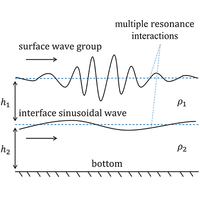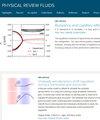Steady-state interfacial gravity waves with one-dimensional class-III triad resonance
IF 2.5
3区 物理与天体物理
Q2 PHYSICS, FLUIDS & PLASMAS
引用次数: 0
Abstract
Steady-state interfacial waves exhibiting class-III triad resonance are investigated in a two-layer liquid with a free surface. Two independent linear dispersion relationships related to surface and internal modes exist in the idealized model. One-dimensional class-III triad resonance requires the presence of two short surface wave modes and one long internal wave mode in a copropagating wave system. Convergent series solutions are achieved by the homotopy analysis method (HAM) for steady-state interfacial wave groups involving resonant triads and quartets. Unlike conventional progressive interfacial waves that have small surface amplitude and large interface amplitude, the free surface wave height is far larger than that of the internal interface waves because the resonance interactions comprise multiple surface wave modes and a single internal wave mode. As the upper layer thickness increases, energy from the interface is transported to the free surface, and energy in the whole wave system shifts from shorter to longer resonant triads and quartets. Our results indicate that steady-state interfacial waves with class-III exact and near-resonance interactions among surface and internal wave modes could occur in cases representative of the real ocean.

具有一维 III 类三元共振的稳态界面重力波
研究了具有自由表面的双层液体中表现出第三类三元共振的稳态界面波。在理想化模型中,存在两个与表面和内部模式相关的独立线性弥散关系。一维 III 级三元共振要求在共传播波系统中存在两个短表面波模式和一个长内波模式。对于涉及共振三元组和四元组的稳态界面波群,通过同调分析方法(HAM)获得了收敛序列解。与表面振幅小、界面振幅大的传统渐进界面波不同,自由表面波高度远大于内部界面波高度,因为共振相互作用包括多个表面波模式和一个内部波模式。随着上层厚度的增加,界面的能量被传输到自由表面,整个波系的能量从较短的共振三元组和四元组转移到较长的共振四元组。我们的研究结果表明,在具有代表性的真实海洋中,可能会出现具有第三类精确共振以及表面波和内波模式之间近共振相互作用的稳态界面波。
本文章由计算机程序翻译,如有差异,请以英文原文为准。
求助全文
约1分钟内获得全文
求助全文
来源期刊

Physical Review Fluids
Chemical Engineering-Fluid Flow and Transfer Processes
CiteScore
5.10
自引率
11.10%
发文量
488
期刊介绍:
Physical Review Fluids is APS’s newest online-only journal dedicated to publishing innovative research that will significantly advance the fundamental understanding of fluid dynamics. Physical Review Fluids expands the scope of the APS journals to include additional areas of fluid dynamics research, complements the existing Physical Review collection, and maintains the same quality and reputation that authors and subscribers expect from APS. The journal is published with the endorsement of the APS Division of Fluid Dynamics.
 求助内容:
求助内容: 应助结果提醒方式:
应助结果提醒方式:


